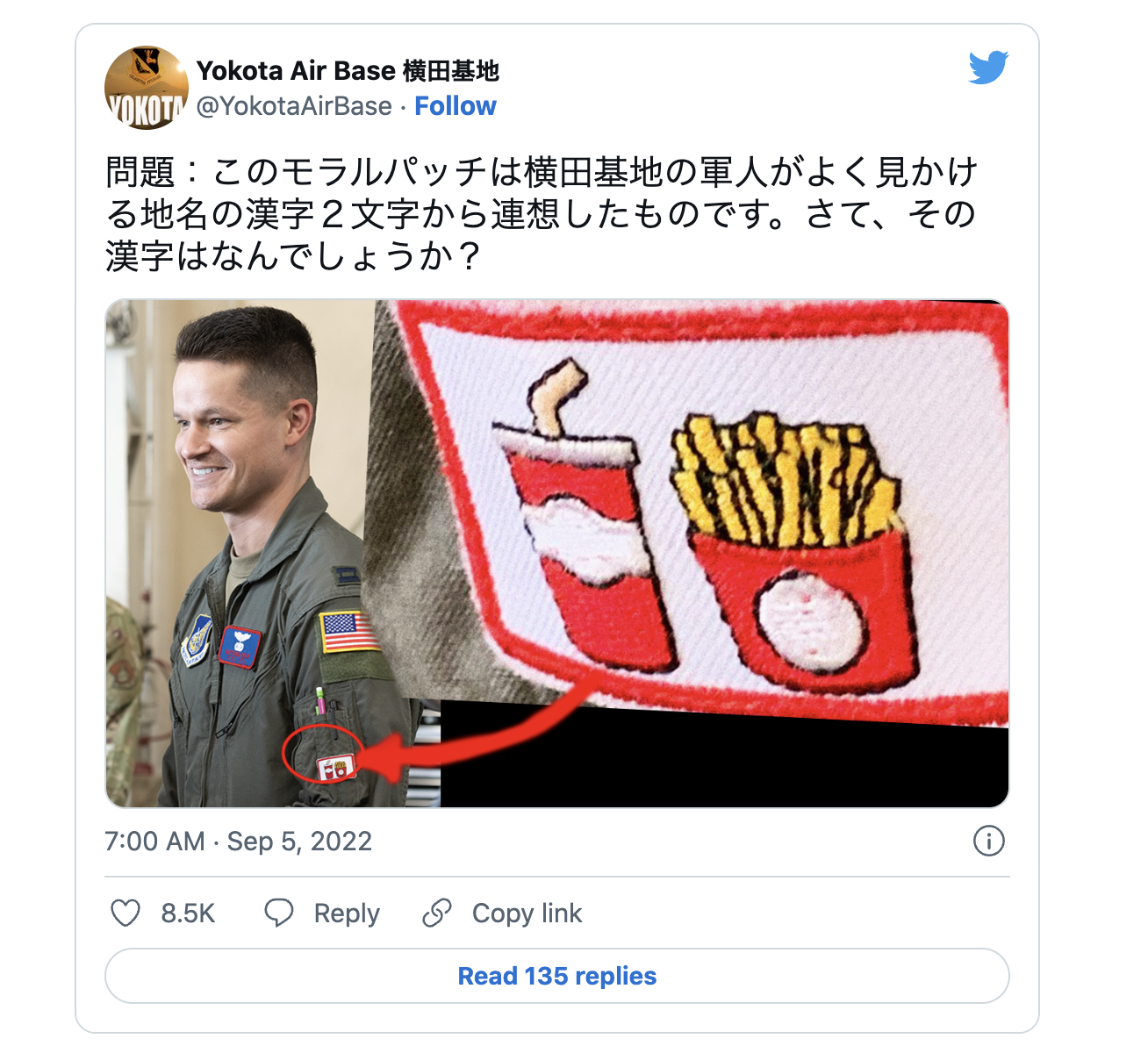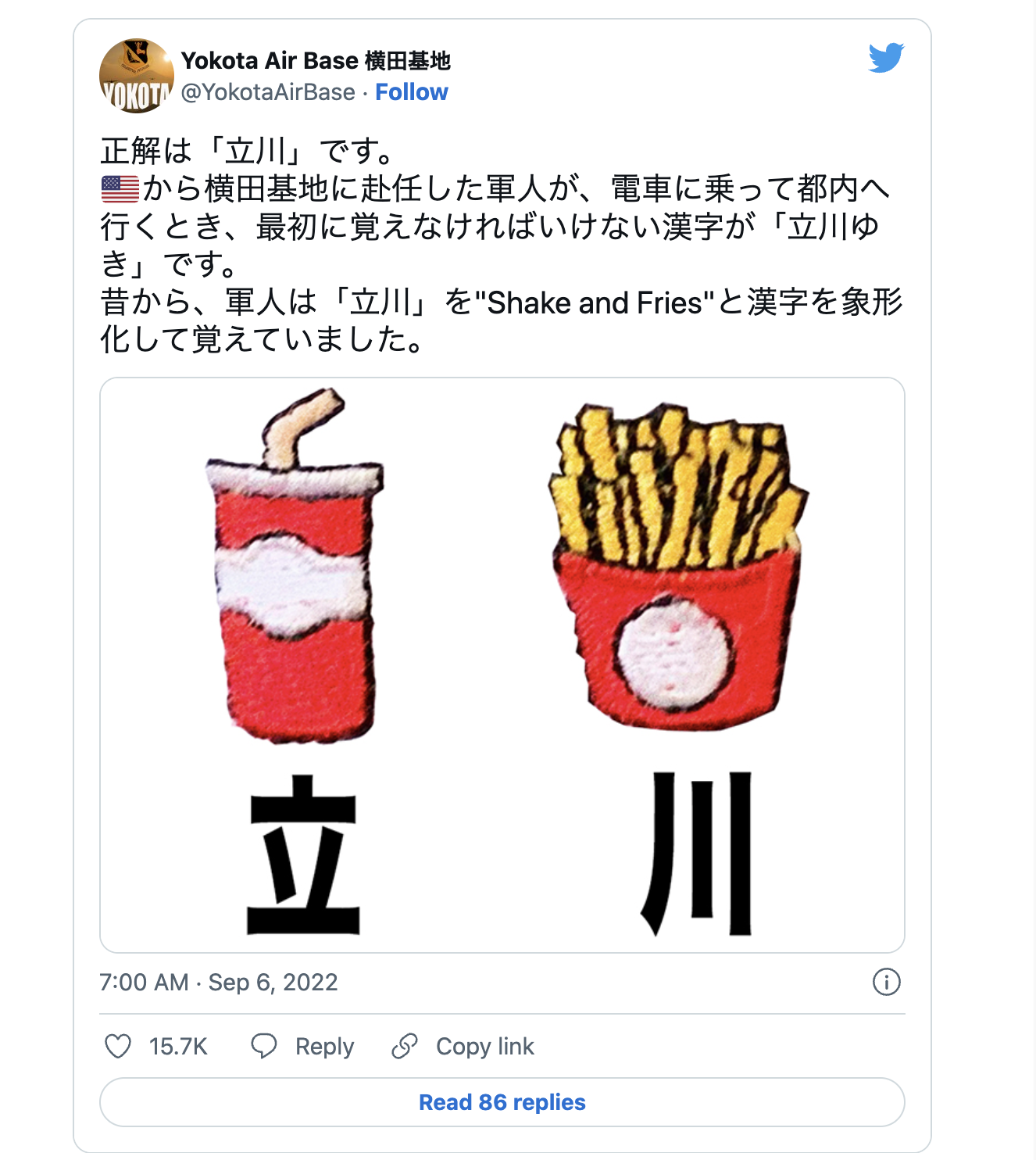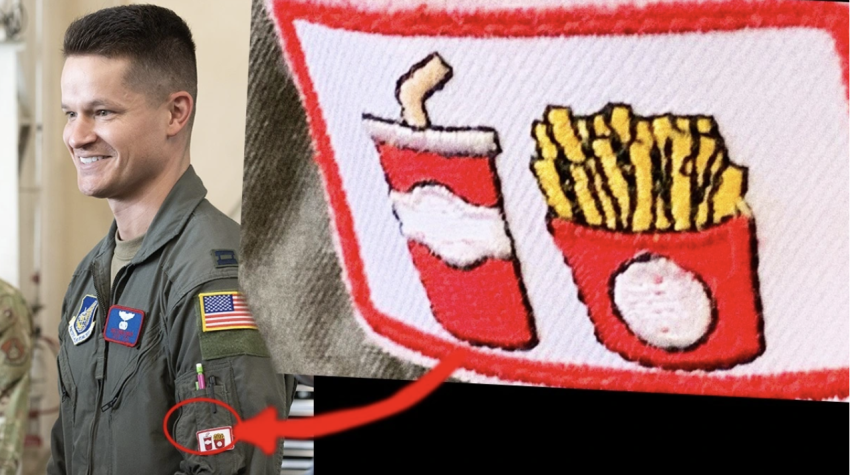For newly arrived foreigners in Japan, navigating the country can be a challenge. Even once you get over the difficulty of remembering place names themselves in a language unfamiliar to you, there’s still the matter of remembering the kanji characters they’re written with.
If you don’t already have a background in Japanese linguistics, oftentimes it’s helpful to remember/recognize kanji by associating them with a picture of some kind. An example was recently shared by the U.S. Air Force’s official Twitter account for Yokota Air Base.
▼ “Quiz: This morale patch reminds Yokota Air Base personnel of a two-kanji name place that they often see. What is it?”

Yep, that’s a fast-food beverage cup and container of French fries, not some sort of military ordinance. And no, they’re not stand-ins for “Yokota” (which is written in kanji as 横田), though they are representing the name of somewhere near the base in western Tokyo. Any guesses?
The answer is…

…Tachikawa!
Unlike some kanji, the characters for Tachikawa, 立川, are pretty straightforward. The first, 立, means “stand” or “rise,” and is meant to be a picture of a man standing on the ground. The second, 川, means “river,” and shows flowing currents of water. Both of those visual renderings are a little on the abstract side, though, and to some of the non-linguistically trained eyes at Yokota Air Base, they look closer to a milk shake and an order of fries.
As to why it’s important for those stationed at Yokota to be able to recognize the kanji for Tachikawa ASAP, Tachikawa Station is the closest major rail hub to the base, and often the station where you’ll need to transfer if you’re heading into downtown Tokyo from Yokota or on your way home, so being able to spot the “shake and fries” is a necessary life skill.
Obviously, native Japanese speakers/readers don’t need this mnemonic device, but Japanese Twitter commenters were all smiles after learning about it.
“What a fun way of thinking! I’d never forget this!”
“Smart idea to be able to recognize them right away.”
“Haha it totally looks like a shake and fries to me now.”
“Please, somebody, make stickers of this!”
“I’d heard that kanji look like pictures to people who don’t read Japanese. Turns out it’s true!”
“That’s really funny and clever.”
“Useful idea!”
“Oh wow, I just saw one of those patches yesterday! So that’s what it was.”
Morale patches, by the way, aren’t official uniform components, and are instead optional gear accents, so you won’t see each and every person stationed at Yokota sporting one. In recent years it’s also become increasingly common for rail networks to list the names of stations on platforms and transfer signs in both kanji and the English/Latin alphabet, so the food-and-drink association isn’t quite as critical as it once was. Yokota’s tweet says that the “shake and fries” technique is one that base personnel have been using since long ago, though, and it lives on as a sign of comradery among those in the know.
Source: Twitter/@YokotaAirBase
Read more stories from SoraNews24.
-- Japanese dad transforms his kids into Studio Ghibli stars, Sailor Moon Senshi in amazing artwork
-- Japanese cook uses sushi-making as inspiration for beautifully artistic bread loaves
--Japanese school renames boys, girls uniforms as “Type I” and “Type II” in gender identity reform
- External Link
- https://soranews24.com/2022/09/10/the-hidden-meaning-of-the-u-s-air-forces-shake-and-fries-patch-in-japan/
 Take our user survey and make your voice heard.
Take our user survey and make your voice heard.















15 Comments
Login to comment
starpunk
Please don't bring up that unamerican disgrace.
I know some veterans who go overseas to Japan, Korea, Germany and lately the Middle East. They do learn some of the language, but the writing systems can be (and often are) pretty complicated. I've been told that since Arabic has a true alphabet, it's not really that difficult to learn. Korean the same way. For some 'newer' jobs such as the cyberwar field, you have to write programs that will act as viruses and trojan horses on enemy computers. That means learning the languages themselves (AND their writing) as well as the computer coding 'languages' they use; syntax and all.
For US personnel who don't need to know these 'exotic' languages so intensely, stuff like this can be a good help in getting around.
BeerDeliveryGuy
In the US military, yes and no.
The Marine Corps have no unit patches, and rank and skill badges are metal pins.
The US Army (from what I’ve observed) is more lenient to morale and humorous patches and badges.
Of course no service person would wear these in an official function, but in the field, whatever the 1LT tolerates is good to go.
From what I’ve seen from my experience working with the SDF, they have all sorts of patches. Some official and some not, and their patches were a pretty hot trade item with US troops.
wallace
I think it's illegal to add any sign or patch to a military uniform not issued by the military.
Desert Tortoise
Ok, I'm not being snarky or sarcastic here. Ex Pacific Fleet sailor, well Navy pilot, so guilty as charged! How do you pronounce it? I am going to throw one other name I have probably been butchering all these years, Matsushita as in Matsushita Electric. I have long thought it was pronounced like "mat-SHOOS-ta". I try to pronounce the names of places and people correctly out of respect but as I mentioned Japanese is a tough language for the western tongue.
Peter Neil
Now if US service people could figure out how to pronounce Yokosuka correctly, that would be a miracle.
Where are you stationed? At Yokuska!
Mickelicious
A friend once called his then fiancée to say he was lost in central Tokyo.
He stopped a passerby to read the name of the location for him from the map he was pointing to:
His beloved, used to his dimwittedness, asked what characters he could see closest to him on the map.
came the reply.
Fighto!
His name is actually Donald McDonald in Japan.
Desert Tortoise
Elvis, when you are in the military you are sent abroad to utterly unfamiliar places with languages and alphabets you have never before encountered and expected to get along there. Unless your job requires a specific language skill there is no language training before you are sent abroad. You go from some stateside posting to Japan, or maybe from Germany or UAE to Japan. That fellow in the photo is a mid career officer, an Captain, and it appears he has wings on his flight suit. He will have a university degree and years of training behind him to get those wings. It is like my own dear wife who is an accomplished electrical engineer but she came from China and speaks what can charitably be called Engrish. I have to help her a lot. No reflection on her intelligence. English is a hard language to learn and Japanese is considered to be one of the most difficult. You also have to understand military humor. Stuff like that is funny and builds camaraderie.
garypen
For a second, I thought that was the ID patch for ex-President Trump's security detail. Then I remembered that his was ketchup packets. Not patches. Just actual ketchup packets pinned to their jackets.
BeerDeliveryGuy
Good thing you weren’t around when bomber crews painted pinup models on their planes and field manuals were in comic book form, featuring “Buxom Betty.”
Tom San
I thought McDonald's retired Ronald McDonald.